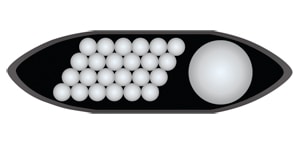Earlier this year, offshore tournament anglers using a Garmin fish finder held a solid bottom reading en route to Bermuda: 17,624 feet. Yes, a transducer was able to get and maintain a reading from three miles below the surface. (Read the full story here on Ben Ellison’s Panbo blog.) This was made possible thanks to the CHIRP transducer technology from Airmar. Here’s how it is changing the game.
Traditional marine fish finders operate by transmitting two fixed frequencies: 200 kHz, a short high-energy wave for shallow water; and 50 kHz, a long low-energy wave for deep water. The traditional transducer houses one broadband ceramic to produce these fixed frequencies, which are shorter in duration with a narrower band.
Airmar brought CHIRP to market last year, importing military technology, which was being used as far back as World War II, into the recreational marine market. Airmar worked with companies such as Navico (Simrad and Lowrance), Raymarine and Garmin to develop black-box sonar units to work with their fish finders.
CHIRP stands for “compressed high-intensity radar pulse” and differs from traditional sonar in that it uses a sweeping pattern of many frequencies with a long duration transmit pulse. It allows CHIRP fish finders to operate at a low and high frequency range, as well as a low and medium frequency range to bring back a much more consistent — and accurate — return.
Airmar’s CHIRP transducers are larger than traditional ones, because they work by employing more broadband ceramics in the housing. Airmar offers four types of CHIRP transducers: in-hull, transom-mount, through-hull and small-boat. Within those, it offers three levels of transducer, based on the number of ceramics inside.

The core transducer features one big and seven small internal ceramics. The hardcore transducer features one big and 15 small ceramics. The elite transducer features one big and 24 small ceramics. Prices range from $750 for the basic small-boat CHIRP transducer to more than $4,500 for the highest level — the one that’s going to hold bottom at 16,000 feet.
For More Information About Chirp Technology:
The Latest Electronics for Your Boat








